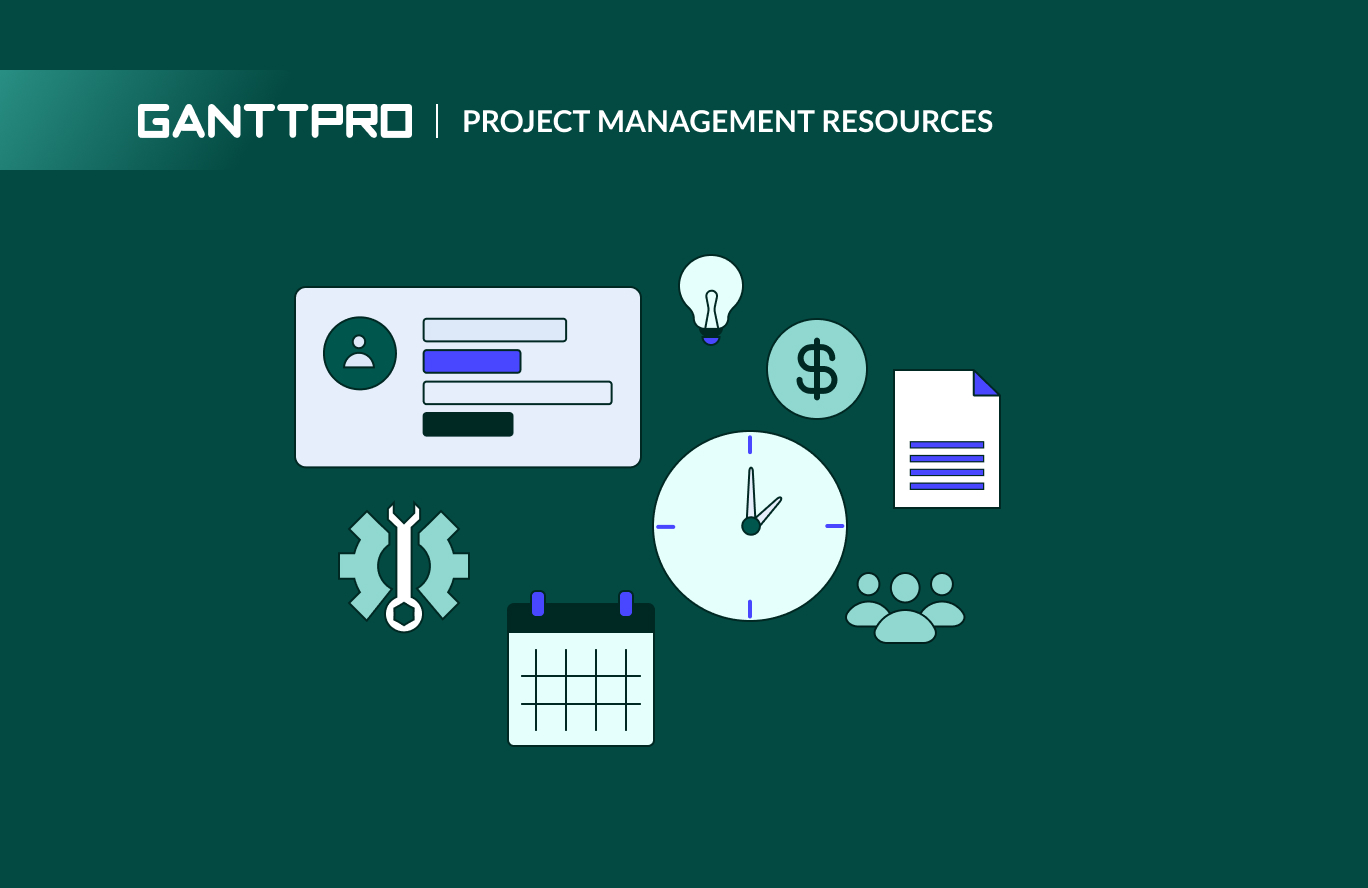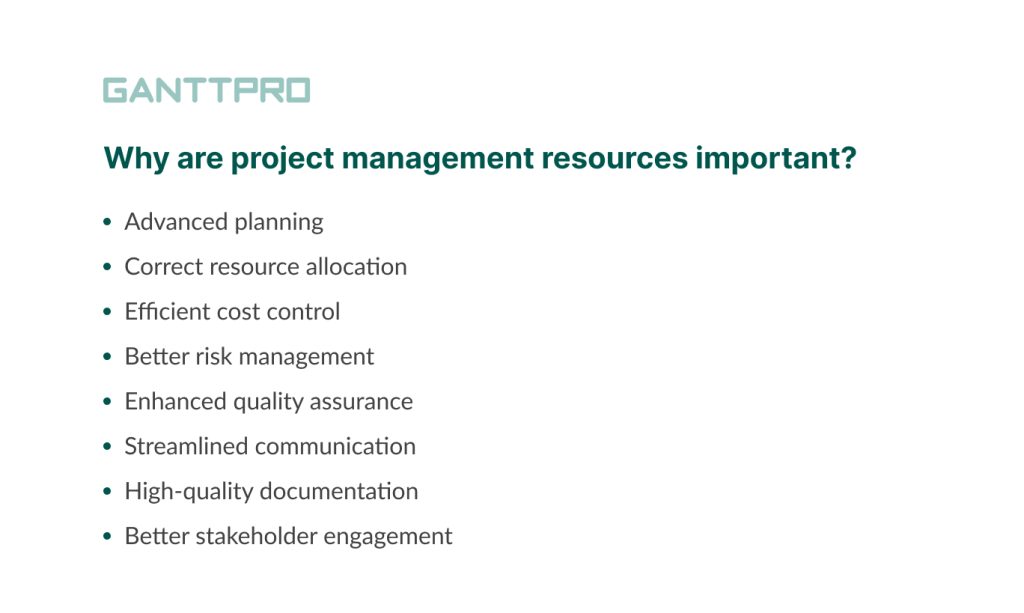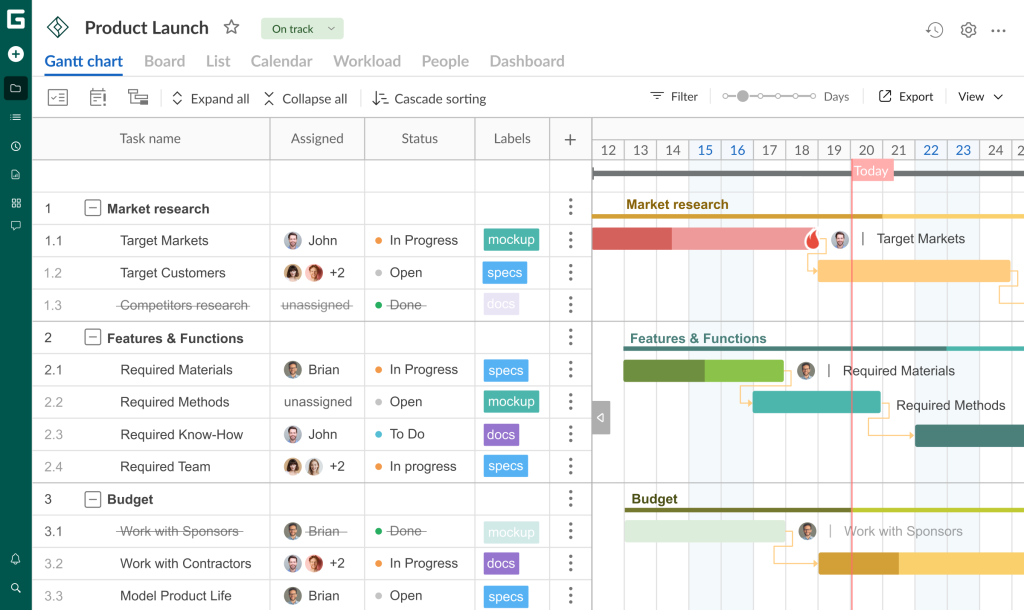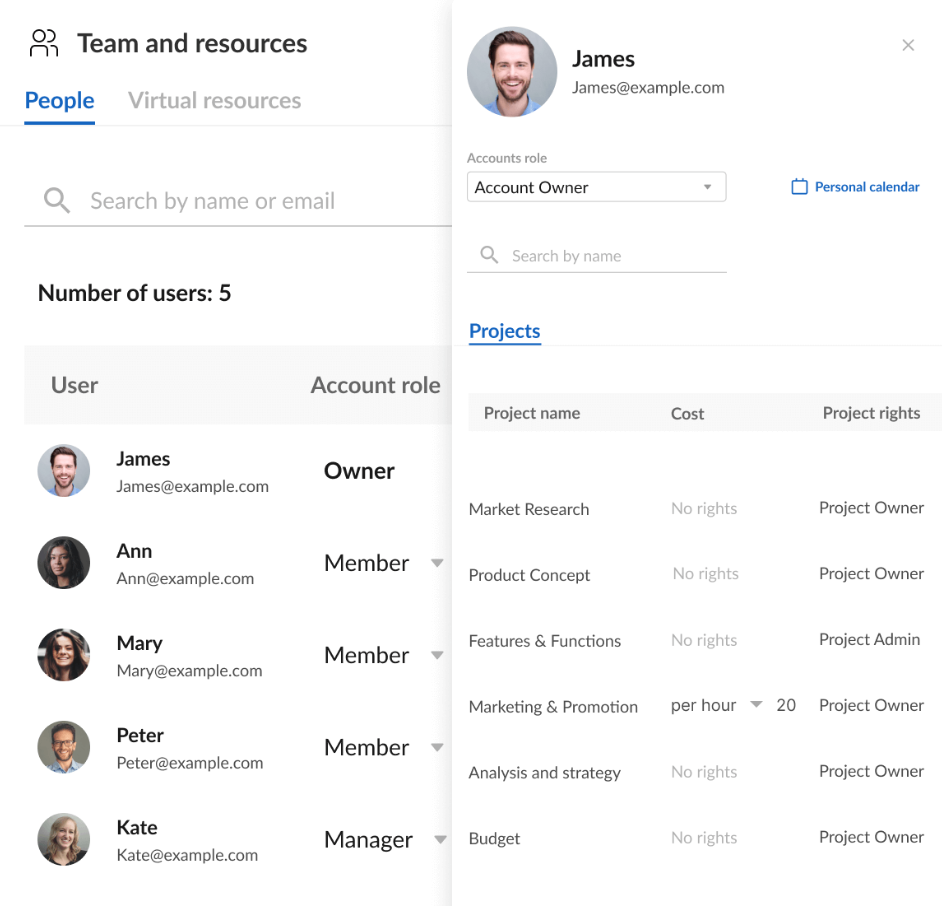What Are Project Management Resources? Ultimate Guide With Types and Examples

Audio version:
If a project is a complex organism, then project management resources are functional elements that make this organism viable and moving forward towards its goals. Without these elements, you won’t be able to deliver your work on time and achieve high-quality results.
Regardless of the industry, any project involves at least several types of resources, whether it’s cost management or a staff shift organization. Therefore, comprehensive resource allocation in project management occupies a vital place in the skill set of any project manager.
What are the key project management resources essential for the success of a project and business overall? How to plan and allocate them using professional software?
Find the answers to these questions and other insights right in this article.
Contents:
- What are resources in project management?
- Why are project management resources important?
- Types of resources in project management.
- Classification of PM resources depending on a certain stage of the project life cycle.
- Choosing robust software for efficient project resource management.
What are resources in project management?
Project resources are necessary assets that are used for achieving strategic goals and successful project implementation.
These resources can be considered the building blocks that assist PMs in planning, executing, and completing projects successfully.
Understanding the resources project management requires is the foundation for teams before they start creating a project plan, selecting the best solution among available resource management methods, and identifying appropriate resource management tools for successful work.
Here’s what Elizabeth Harrin, the author of several books about project management, claims:
The most common overlooked dependency when managing multiple projects are resources. Having an awareness of the resources that you are booking for your project or that you need to provide input to your work is really important.
In brief, project management resources encompass anything or anyone that can be scheduled or booked to fulfill specific tasks or a project.
It is critical to evaluate and allocate resources before starting a project as well as forecast possible resource constraints. Insufficient resource planning for multiple projects can result in resource shortages during work execution or delays in meeting established deadlines. Therefore, effective resource organization is a key factor in project management, exerting a substantial impact on the project’s overall success.
Why are project management resources important?
Resource management best practices and available resource management techniques move projects forward and make them better. However, this is a very general definition, and you definitely want to know the clear reasons for their importance or specific benefits that resources provide.
Let’s sort them out and determine why they are significant.

- Advanced planning. Initial project plans require skilled team members, timely arranged meetings, proper facilities, and other resources. It ensures that all necessary timelines, schedules, and tasks are considered from the outset.
- Correct resource allocation. Project resources help assign the right people to the right tasks based on their availability and skills. It optimizes workforce productivity.
- Efficient cost control. Project assets also play a crucial role in budget management. Tracking finances and resource utilization leads to preventing cost overruns.
- Better risk management. Risk control is essential in project management. Such resources as experienced project managers and risk assessment tools help in proactive risk mitigation.
- Enhanced quality assurance. Various types of project management resources help determine and maintain quality standards. It guarantees the expected outcomes.
- Streamlined communication. Communication tools and processes ensure that stakeholders are informed about project progress, changes, and issues, fostering alignment and transparency.
- High-quality documentation. Proper documentation resources, including project schedules, invoices, reports, and other docs ensure that project data is organized and accessible.
- Better stakeholder engagement. Smooth relationships with stakeholders are vital. Resources for stakeholder analysis and engagement strategies facilitate effective collaboration and motivation.
So, what are the typical resources project management involves?
Types of resources in project management
Resources in project management can be presented in different forms. You can probably guess some of them. Others may not immediately come to mind.
A distinction is usually made between tangible and intangibe assets.
- Tangible resources encompass all measurable assets with a physical presence. They usually can be measured in numbers.
- Intangible resources, conversely, lack physical representation. Their project value cannot be quantified distinctly.
Besides the tangible-intangible categorization, project management resources are usually divided into 7 types.
But please note, that you may come across different variations of their meanings and titles. Here we offer the most common classification.
So, these 7 resources are:
- Human resources.
- Financial resources.
- Time.
- Consumables and materials.
- Equipment and tools.
- Facilities.
- Information and knowledge.
This classification of resource types in project management covers different industries and fields of activity.
Let’s look at each asset in more detail.
1. Human resources

People are the driving force of any project. While technology and artificial intelligence are increasingly replacing human involvement, teamwork is what keeps projects on track from start to finish.
In most cases, a high performing team has a more significant impact on the project’s success than any other resource. You may have a substantial budget (financial resources), the best software solutions (tools and equipment), and a comfortable office space (facilities). However, your project won’t make progress if you lack skilled specialists.
Susanne Madsen, the executive coach and PM trainer from the UK, reinforces this idea with her thoughts:
More and more project managers are waking up to the fact that projects aren’t just about tasks and schedules, but also very much about people. Everyone would like to be part of a high performing team, but too few managers and leaders put in the effort to create one.
To advance projects, all team members must possess the skills and experience required to make informed decisions and execute their tasks effectively.
At the same time, people can be considered the most complex resource due to their diversity. Individuals may have their unique backgrounds, work styles, and potential cultural differences that can lead to conflicts and interpersonal tensions.
Furthermore, managing labor resources can be a real challenge because of their availability and allocation. Workers may become ill, go on vacation, take parental leave, or experience burnout. Consequently, effective human resource allocation becomes a significant responsibility for many project managers.
Example of a human resource in project management
Human resources in various industries can include team members, partners, contractors, and other stakeholders. Some projects may require only a few people, while the implementation of others involves large departments with full-time and part-time employees. Remote workers are also a part of this resource calendar.
Let’s consider an average IT project. A team involved in software development tasks may contain:
- Project owners.
- Project managers.
- Product managers.
- Departments.
- Individual specialists (developers, designers, QA specialists, etc.).
- Team leads.
- Freelancers.
- Outsourced specialists, and other staff.
These human resources are engaged in different professional areas and tasks. However, by having appropriate IT project management software and following competent management principles, they can act cohesively and lead their projects to success.
2. Financial resources

Money is also a crucial type of resources in project management. It is necessary to fund various aspects of a project, such as labor, equipment, and other assets.
Effective budget management entails creating a financial plan, monitoring expenses, and ensuring the project remains within cost boundaries.
In most cases, budgets are planned, documented, and approved at the earliest stages of project development. However, allocating money is not always an easy task for managers, so many of them use ready-made monthly budget planner templates for convenience. They can be quickly customized and you don’t need a special financial expert for assistance.
Project specialists must treat this resource with great responsibility as it helps them to purchase, acquire, and maintain all other resources within their projects.
Example of a financial resource in project management
To outline an example of budget assets, let’s consider a project from the marketing sphere.
When scheduling and allocating finances, marketing project managers usually determine:
- General marketing project budget.
- Project grants.
- Contingency funds.
- Partner programs budget, etc.
A marketing project budget can be used for creative campaigns, advertising, branding, PR events, content, video materials, etc. It’s better to plan and control it using professional marketing project management software.
3. Time

This type of project management resource refers to the time required for project tasks, encompassing timelines, deadlines, and project milestones.
Effective time management involves creating realistic timelines, identifying and resolving potential time constraints, reducing project delays, and monitoring progress to keep tasks on schedule.
Project managers estimate task durations and project phases when planning projects to create precise schedules and calculate costs, which require client approval. Following project completion, they analyze time tracking data to assess team performance, time and cost budgets, and leverage this information for enhancing future endeavors.
Example of a time resource in project management
This type of resources in project management may include any time-related element that is aimed at task completion.
Let’s imagine a project in the healthcare sector. Below are the examples of time resources that can be involved:
- Healthcare project schedule.
- Task durations.
- Project calendar.
- Time reports.
- Work shifts.
- Night duty schedules.
- Emergency service hours, etc.
4. Consumables and materials

Consumables and material resources are tangible assets essential for a project. Efficient organization of these resources entails identifying and acquiring required items, monitoring inventory levels, and ensuring effective material utilization.
Some projects require a small amount of materials while others can be completed only with a wide range of material assets.
Example of conumables and materials in project management
Let’s explore the significance of consumables and materials in a construction project.
For instance, typical materials for a bridge construction project are:
- Soil.
- Raw materials (wood, steel, concrete, etc).
- Consumables (fuel and chemicals).
- Spare parts for repair.
- Office supplies (paper, pens, and other office stuff).
- Hardware, etc.
Consumables and materials in construction are a resource that is very easy to lose or get an oversupply. Therefore, project managers must take care of proper planning and control of such assets using reliable construction project management software.
5. Equipment and tools

Equipment and tools are crucial in project management as they ensure seamless project execution. For instance, PCs and various software solutions are often essential for many project tasks.
Unlike materials, these resources remain not used up throughout the project duration.
Equipment and tools cover both physical and non-physical assets. Within the technical context, tools can be further categorized into hardware and software.
Example of tools and equipment in project management
There are many tools and types of equipment that are essential for carrying out various project activities efficiently.
Let’s consider some examples of tools and equipment needed for a manufacturing project.
- Workshop machines.
- Laboratory equipment.
- 3D printers.
- Vehicles.
- Testing equipment.
- Communication tools, etc.
The key characteristic of this type of resource in manufacturing is that it can be represented by both a tiny desktop tool and a huge piece of equipment that occupies the space of an entire production workshop. It means that it is very important not to get confused and keep control over all assets. Well-chosen manufacturing project management software professionally assists.
6. Facilities

Facilities or space resources constitute physical infrastructure and environment that project teams require to complete their work including office spaces, storage space, and any workspaces.
Planning and organizing these facilities involves identifying the necessary spaces and ensuring that they are appropriately configured.
When you have appropriate facilities, you can improve your team members’ productivity and enhance communication.
Example of facilities in project management
Let’s say, you are planning a seasonal educational project. Here are some examples of facilities you may need:
- Data center.
- Conference rooms.
- Office space.
- Accommodation.
- Storage facilities.
- Educational laboratories.
- Training rooms, etc.
7. Information and knowledge

Project teams in various spheres use informational resources to complete their projects most professionally. Such resources typically include knowledge bases, facts, research, reports, and any documentation.
Successful management of information involves collecting necessary data, ensuring that it is up-to-date and accurate, as well as sharing it with the people involved in a certain project.
So, the key goal of this type of resources in project management is to keep project managers and teams informed about their project’s current state.
Example of information and knowledge resources in project management
If you imagine any average project in the sphere of event planning, you’ll quickly realize the power and meaning of informational resources.
In the context of event planning, we can define the following examples of such resources:
- Event guidelines and checklists.
- Registration forms.
- Event timelines.
- Vendor contracts and agreements.
- Legal documents.
- Attendee lists.
- Partner profiles.
- Promotion plans.
- Event risk assessment.
- Venue specifications.
- Event surveys.
- Event evaluation reports, etc.
Classification of PM resources depending on a certain stage of the project life cycle
In the project management environment, resources can be also classified based on a specific stage of the project life cycle for which they are required. This classification includes the assets that are listed below.
- Resources for project initiation. They involve everything necessary for project managers to formally initiate their projects, such as initial documentation and team meetings.
- Resources for planning. This type of resources in project management assists teams in meticulously planning every aspect of their projects. It may include timelines, project scopes, budgets, and potential risk assessments.
- Resources for execution. These resources are vital for carrying out the actual project work. They consist of various templates, execution guides, and popular project management methodologies.
- Resources for monitoring. PMs need to continuously track and assess the progress of their projects to make adjustments to their original plans. Resources like change management plans and guides aid them in this process.
- Resources for project completion. These assets help managers to formally close out projects. They comprise final project documentation and retrospective meetings, which serve to enhance processes and facilitate future improvements.
Now let’s move on to the importance of using the right online tool for effective resource management.
Choosing robust software for efficient project resource management
If managers wonder how to allocate resources in project management professionally and want to gain respect among their teammates and rivals, they should care about each project process, including resource allocation. Therefore, it’s better to forget about paper and pen or other elementary means for planning and organizing work and opt for reliable project management software.
The primary goal of a resource management tool is to ensure the timely availability of the right resources in the right amounts and locations, facilitating efficient project completion within budget and schedule constraints.
Ray McKenzie, the founder and CEO of StartingPoint, the USA, admits:
It is extremely important to select the right tools to ensure a project is completed successfully. Project managers should utilize tools that provide visibility for the entire team, provide clear structure for projects, and encourage collaboration. I recommend the use of newer SaaS tools allowing all project team members to participate, provide feedback, and work towards successful projects.
With so many different resource scheduling tools available, figuring out which is right for your team is tough. By the way, according to the Tech Trends Report (Capterra, 2024), 58% of businesses surveyed regret a recent software purchase.
At the same time, 79% of individuals utilizing resource management-focused tools reported satisfaction or high satisfaction, which is reflected in the State of Resource Management report (2022).
Luckily, modern PM platforms come with many advanced tools and features for efficient resource management, including a handy Gantt chart.
One of the examples of a trustworthy Gantt chart-based tool for this aim is GanttPRO.

This online Gantt chart maker offers powerful PM functionality that facilitates successful outcomes in diverse industries such as IT, construction, events, manufacturing, and more.
GanttPRO helps professionals enhance and improve project management, task planning, event tracking, deadline control, team collaboration, and advanced resource scheduling.
Teams select GanttPRO for project planning, task organization, and effective resource allocation, acknowledging its reliability as resource management software.
How does GanttPRO make managing resources easier?
Using advanced GanttPRO features to work with project management resources makes planning, tracking, and coordinating processes stress-free and more accurate.
This is confirmed by George Rossle, a production manager at A+ Construction Pro, who says:
For us, GanttPRO is a basic tool for planning and management. We invite our colleagues to projects as well as create resources. We use the software for deadline management and time tracking, file sharing, and smart scheduling.
Resource identification begins when managers start to determine project goals, a scope, financial aspects, and create a resource management plan. At this point, it’s essential to define resource types, as well as their quantity and quality aspects. Luckily, GanttPRO allows for working with all types of resources.
Here’s a concise overview of how GanttPRO can be used for various resource-related activities.
- Resource visualization. It’s better when project management resources are stored and visualized in one easily viewed location. But before planning and visualizing resources on a Gantt chart, you need to divide your project into manageable tasks and subtasks, using a work breakdown structure (WBS). With the drag-and-drop feature, you can visualize task dependencies and place milestones on a timeline. When your tasks are organized, GanttPRO allows for inviting team members and specifying their roles, as well as setting costs and calendars for them. You can also create and organize virtual resources that may include people, types of equipment, tools, buildings, and so on.

- Resource allocation. In GanttPRO, you can assign specific team members or resources to tasks. A visually appealing Gantt chart with resource allocation ensures that resources are distributed appropriately based on their skills and availability. You can allocate one or several assets to each task.
- Time tracking. With the software, you can track time professionally, allowing your colleagues to log their working hours on specific tasks. This data assists in evaluating project progress and resource performance.
- Cost estimation. The Gantt diagram generator allows for efficient budget management and cost estimation. You can schedule finances for a project and monitor expenses in real time, staying within cost constraints. It’s possible to define costs for all resources per hour, per item, or just cost.
- Personal calendars. GanttPRO provides its users with the option to assign tasks to assets while configuring personal calendars. With their help, it becomes pretty easy to track how many activities or working hours your resource has every day. You can control days off, vacations, seasonal holidays, and other dates and events.
- Rights and roles. The platform enables users to define specific roles and permissions at the account level as well as rights and permissions at the project level. It means that you can easily specify who can view, edit, or approve your project-related data, ensuring security and access control. Own custom roles and rights can be also added if needed.
- Workload balancing. Effective workload management is also a strong side of GanttPRO. With the drag-and-drop feature, you can schedule work, manage resources, and improve workload planning efficiently. It simplifies task tracking and enables timely resource allocation adjustments to prevent overloading or underutilization. This is what sets powerful workload management tools apart.
- Collaboration. You’ll be always aware of all your PM resources thanks to the advanced means of collaboration in GanttPRO. You can share documents, attach files, get notifications, and communicate at any time.
- Reporting. GanttPRO lets you gather information related to your project management resources and create reports while saving time and preventing possible bottlenecks in the future. Two types of reports are available: time log by people and budget analysis.

Professional resource management software
Complete projects on time, manage workload, and communicate with a team.
Sign up for freeUnleash the full potential of project management resources
Various types of resources in project management are crucial for progressing a project from concept to completion. These assets include anything you need to perform any task in a professional manner.
Project management resources are usually divided into 7 categories:
- Human resources.
- Financial resources.
- Time.
- Materials.
- Tools and equipment.
- Facilities.
- Information and knowledge.
Software solutions like GanttPRO enhance project efficiency, ensuring optimal resource utilization within specified constraints. Opting for such platforms saves time, allowing for increased focus on other project management aspects.
Frequently asked questions about project management resources
-
The three main types of resources in project management typically involve human resources (usually people who are a part of a project team), material resources (physical and tangible assets required to execute a project: equipment, tools, supplies, etc.), and financial resources (budget and funds allocated for a certain project).
-
Materials in project management refer to physical resources or substances required for project execution. Examples of such resources include raw materials, supplies, office stationery, technology assets, consumables, documentation, etc.
Read also
Join 1M+ project managers!
Create Gantt charts in minutes with GanttPRO and reduce time spent on managing tasks by 40%
Try for freeNo credit cards required. No obligation.

